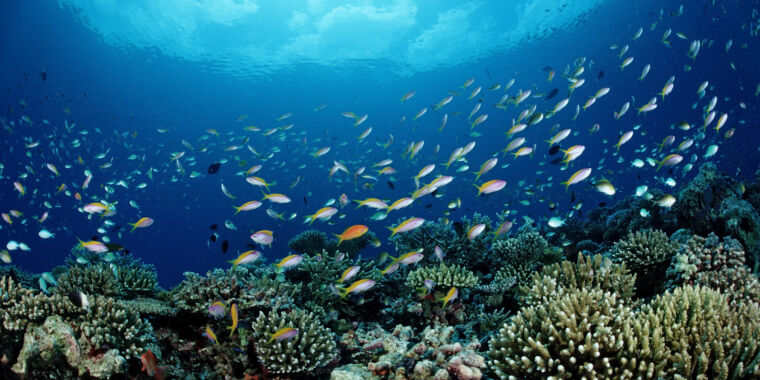Coral reefs, among the most visually captivating marine ecosystems on the planet, are facing a dire fate. It is projected that by 2050, around ninety percent of these reefs will have perished due to escalating ocean temperatures and pollution. However, Dr. Timothy Lamont, a marine biologist affiliated with Lancaster University, remains optimistic about the possibility of restoration, stating, “But it’s not that when they are gone, they are gone forever. We can rebuild them.”
Dr. Lamont and his team conducted an assessment of coral reef restoration initiatives carried out under the MARS Coral Reef Restoration Program along the Indonesian coastline. Their findings revealed that by planting corals on a network of sand-coated steel frames, a completely barren reef was rejuvenated within a mere four years, showcasing a glimmer of hope for ecosystem repair.
Rejuvenation Amidst Ruin
The rejuvenated reef scrutinized by Dr. Lamont’s team had suffered devastation from blast fishing activities conducted three to four decades ago. Describing the destructive practice, Lamont explained, “People were using dynamite to blow up the reef. It kills all the fish, the fish float to the surface, and you can scoop them all up. Obviously, this is very damaging to the habitat and leaves behind loose rubble fields with lots of coral skeletons.”
The incessant movement of this loose rubble posed a hindrance to the growth of coral larvae, as they were frequently displaced before maturation. Therefore, the initial step in reviving damaged reefs involved stabilizing the rubble. This was achieved through the utilization of Reef Stars, hexagonal steel structures enveloped in sand, interconnected and anchored to the seabed to minimize rubble displacement. Prior to the installation of the reef stars, the MARS team manually affixed small corals to them, aiming to accelerate recovery compared to the natural settlement of coral larvae on the steel structures. This proactive approach yielded promising results, although uncertainties lingered regarding the comprehensiveness of the assessment metrics.
Nurturing Artificial Coral Habitats
The primary yardstick employed by Dr. Lamont’s team to gauge the success of the MARS program’s restoration efforts was the carbonate budget, indicating the overall growth of the reef structure. A thriving coral reef typically maintains a positive carbonate budget, generating approximately 20 kilograms of limestone per square meter annually. Remarkably, the restored sites in Indonesia exhibited this healthy carbonate budget. However, the composition of organisms contributing to this budget differed from that of an untouched natural reef.
While an unspoiled reef boasts a diverse array of coral species, including massive, encrusting, and plating varieties like Isopora or Porites, which collectively contribute about a third of the carbonate budget, the rejuvenated reefs were predominantly populated by smaller, branching corals such as Stylophora, Acropora, and Pocillopora. These fast-growing species, initially attached to reef stars, raised concerns about whether the rapid four-year recovery period was achieved at the expense of biodiversity, favoring quicker-growing corals.
Early Recovery Dynamics
Dr. Lamont emphasized the importance of considering the early stages of ecosystem recovery, noting that fast-growing species typically dominate the initial years of regeneration, irrespective of natural or artificial restoration processes. He elucidated, “Bigger, slower-growing species—you wouldn’t see them for decades because they grow so slowly. Even if you haven’t planted corals and waited for the natural recovery to happen, you would still expect a pattern where the fast-growing species would dominate after four years.”
While acknowledging the efficacy of reef stars in swiftly repairing substantial areas, Dr. Lamont cautioned against viewing them as a universal solution for reef restoration. Their effectiveness is limited in hard rock seabeds or areas lacking healthy corals, necessitating the development of diverse methodologies to address varied restoration challenges.
Climate Change Conundrum
Undeniably, climate change looms as the foremost menace to coral reefs worldwide, exacerbating the frequency and intensity of tropical cyclones that ravage these delicate ecosystems, leaving behind widespread devastation akin to blast fishing but on a monumental scale. Although reef stars offer a partial remedy to such damage, they are inadequate in mitigating the detrimental effects of marine heat waves, which pose a severe threat to corals due to their susceptibility to high temperatures, leading to bleaching and symbiotic disruption.
In response to these challenges, Dr. Lamont proposed innovative solutions such as assisted evolution, aiming to breed resilient super-corals capable of withstanding temperature fluctuations. Additionally, techniques like sexual reproduction, involving the fertilization of coral eggs with sperm in controlled environments, offer promising avenues for reef regeneration. While the prospect of rebuilding coral reefs is indeed inspiring, Dr. Lamont underscored the imperative of combatting climate change at its roots, emphasizing the limitations of restoration practices in the absence of sustainable environmental stewardship.
